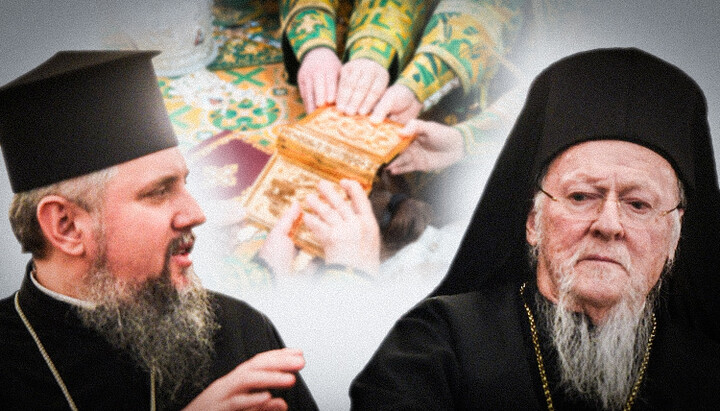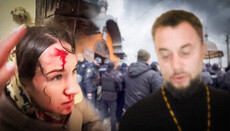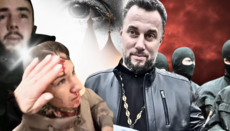Where does the “father” get his canonicity from?

During the seizure of a church in Dubivtsi, a “priest” of the OCU was unable to explain to a common parishioner where his priestly grace came from. Why does this matter?
On 1 April 2025, church raiders seized the UOC Сhurch of the Dormition of the Most Holy Theotokos in the village of Dubivtsi. The method of seizure has been practiced and repeated dozens of times by now. But this case stands out due to a conversation between the OCU “priest” overseeing the takeover, Pavlo Tomenko, and an ordinary Christian woman who asked him a straightforward question: where does the OCU receive the grace of the priesthood?
What’s noteworthy is the very fact that such a question arises among ordinary believers. Over the years of war, “transitions” to the OCU have practically become a national idea. The “hierarchs” of Epifaniy, the authorities, and the media all speak with one voice, telling Ukrainians that they must join Dumenko’s structure. Their arguments are nearly always “national-patriotic”: that it’s shameful to belong to the “Moscow Church” during wartime, that joining the OCU will unite the nation, that Ukrainians should pray in the state language, etc. And there are those who are satisfied with such explanations.
But most believers of the UOC think in entirely different terms – one might even call them “practical”. People come to church not for patriotism but for worship. They want to be confident that their sins are truly forgiven in confession, that they receive the Body and Blood of Christ in Communion, not just bread and wine. And for this, the priest must possess the grace of the Holy Spirit, which is conferred through ordination.
This is precisely what the parishioner was saying to the Dumenko-aligned cleric in Dubivtsi. As she explained, she couldn’t justify a transition to the OCU because she didn’t understand how apostolic succession could have arisen there.
The conversation began with the woman asking Pavlo Tomenko whether he could serve in the city of Christ’s Nativity, Bethlehem. The “priest” called her question a “provocation”. In essence, the question was whether the Patriarchate of Jerusalem, the first and oldest Local Church, recognizes OCU clergy as bearers of priestly grace. A simple question that could’ve had a simple answer, but Tomenko labelled it a provocation. Nowadays, any uncomfortable question can be dismissed as either a provocation or “Russian propaganda”. But the question remains.
The UOC parishioner then tried in vain to find out how apostolic succession appeared in the OCU’s ordinations.
The parishioner’s question: “Why did Bartholomew not recognize the UOC-KP and Filaret?”
Tomenko’s answer: “Because they were in schism.”
This is an important admission, because the OCU “priest” acknowledges that the “ordinations” performed in the UOC-KP and UAOC were never grace-filled to begin with.
The parishioner then asked: “So why didn’t Bartholomew re-ordain those bishops? They were in schism, and he didn’t recognize them — their ordinations hadn’t taken place canonically. Why didn’t he re-ordain them?”
There was no answer. Tomenko just insisted that everything was “canonical”. But if that was truly the case, why was he unable to explain it to a simple woman?
A few years ago, a similar dialogue took place at the highest theological level between the Primate of the Albanian church, the late archbishop Anastasios, and Ecumenical Patriarch Bartholomew.
On 14 January 2019, Archbishop Anastasios, acting on behalf of the Holy Synod of the Church of Albania, sent a letter to Patriarch Bartholomew in which he stated that the “ordinations” carried out by the schismatics were not only invalid but amounted to blasphemy against the Holy Spirit.
“We question, nevertheless, whether the ordinations performed by Filaret, while he was excommunicated and anathematized, acquired thereafter, without canonical ordination, validity from the Holy Spirit and a genuine seal of apostolic succession. [...] It is difficult for us to understand that invalid and non-existent things are being made Spirit-bearing ‘by oikonomia’ and that actions constituting repeated blasphemy against the Holy Spirit [...] are being recognized retroactively ‘by oikonomia’,” the letter said.
It took theologians of the Ecumenical Patriarchate nearly three months to formulate a response to Archbishop Anastasios’ simple question: how can priestly grace appear retrospectively? This, in essence, is the same question posed by a humble believing woman in the village of Dubivtsi in Bukovina. And the answer was the same: everything is canonical.
On 9 March 2019, the official website of the Ecumenical Patriarchate published a response to Archbishop Anastasios. Its essence boiled down to the claim that all decisions made by the Ecumenical Patriarchate are always correct and canonical.
“The God-bearing Fathers, who through the holy and sacred canons have entrusted the Throne of Constantine with its universally recognized hallowed and dread responsibilities that transcend borders – not in the form of privileges but of self-sacrifice – foresaw with the guidance of the Holy Spirit the necessity for a definitive resolution to the problems emerging across the Local Churches, which are unable to settle them by themselves,” the response read.
The Albanian Church expressed its doubts most clearly and consistently regarding the possibility of grace appearing retrospectively among schismatics but it was not alone.
On 21 February 2019, the Holy Synod of the Romanian Orthodox Church issued a statement on the religious situation in Ukraine, saying: “The Romanian Patriarchate will ask the Ecumenical Patriarchate to clarify the issue of the non-canonical hierarchs and clergy who formerly belonged to the ‘Kyiv Patriarchate’.” That clarification has still not been provided.
On 18 February 2019, the Holy Synod of the Church of Cyprus issued a communiqué stating: “The two-thousand-year experience of the Cyprus Church and the entire Orthodox Church as a whole gives us reason to doubt the possibility of legally backdating those ordinations that were committed by banned, excommunicated and anathematized bishops.”
Sadly, the Church of Cyprus later decided that the argument “the Phanar knows best” was sufficient, and allowed its Primate to commemorate and concelebrate with Serhii (Epifaniy) Dumenko, although this does not equate to full recognition.
Many hierarchs of the Church of Cyprus still hold their original stance and do not recognize the OCU. For instance, in February 2019, Metropolitan Nikiforos of Kykkos and Tillyria said: “I have come to the conviction that we, the Holy Synod of the Church of Cyprus, cannot recognize schismatic Epifaniy, who has no canonical ordination, as the canonical Metropolitan of Kiev and All Ukraine. The more so that from the point of view of the canons, we are not allowed to have the Eucharistic communion with schismatics, especially, self-ordained ones.”
A similar situation unfolded in the Church of Greece. On 11 September 2019, 179 clergy, monastics, and laypeople of the Church of Greece published an open letter to Archbishop Ieronymos of Athens, stating the following on ordinations: “Almost all Local Churches have serious doubts about the canonicity and legality of the priesthood of the new Church (i.e., the OCU).”
Despite this stance, the Church of Greece eventually recognized the OCU. However, many hierarchs still do not accept it and do not permit OCU representatives to serve in their dioceses.
The inability to explain the origin of grace in the OCU episcopate, or, more precisely, the understanding that there is none, is the UOC’s key condition for beginning talks on unity with the OCU. The decision of the UOC’s Local Council in Feofania on 27 May 2022 formulates this condition as follows: “To resolve the issue of the canonicity of the OCU hierarchy, because it is quite obvious for the Ukrainian Orthodox Church, as well as for the majority of Local Orthodox Churches, that to recognize the canonicity of the OCU hierarchy, it is necessary to restore the apostolic succession of its bishops.”
Yet neither the OCU nor the Church of Constantinople appears willing to resolve the issue of apostolic succession. The problem of the OCU’s lack of valid ordinations is not going anywhere. The conversation between an OCU “priest” and a believing woman in the Bukovinian village of Dubivtsi shows that the question of grace is not only one for theologians and hierarchs – it is a question for common parishioners.
And they deserve an answer. A credible, reasoned answer, not a brush-off like “the giraffe is tall, it sees better”. Only a Pan-Orthodox Council can give this answer and resolve the existing contradictions on behalf of the whole Church. Many hierarchs from various Local Churches have called for such a council. But Patriarch Bartholomew, to whom these appeals are primarily addressed, continues to refuse. Could it be because he is well aware of the fallacy of his actions and fears exposure?
A brief allegory
And finally, a brief allegory. To draw water from a spring, it is not enough to come with a bucket or container, nor merely to make a motion called ‘drawing’. There must be water in the spring the moment one comes to it. If there isn’t any, one leaves with empty buckets even if the “drawing” motion was made. And so, according to the logic of the Patriarchate of Constantinople, before 2018, when there was “no water” in the spring, the “bishops” and “priests” of the schismatic denominations (the UOC-KP and UAOC) came and drew (performed the rite of ordination), and then went off to nourish their flocks with this non-existent “water”. Then, the Phanariotes supposedly opened the spring by decree. Let’s assume that water did indeed appear in it. But where did it come from in the buckets of those who had drawn from it earlier? Shouldn’t they come again and draw properly? The Phanariotes say no.
This allegory, like any comparison, cannot fully capture the depth of what is happening. But it helps to illustrate the absurdity of the logic used by those who claim that water can appear retroactively in the bucket, simply by the snap of one hierarch’s fingers. Even if that hierarch bears the grand title of “Ecumenical Patriarch”.









